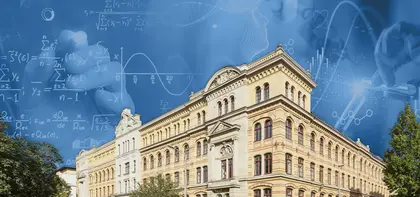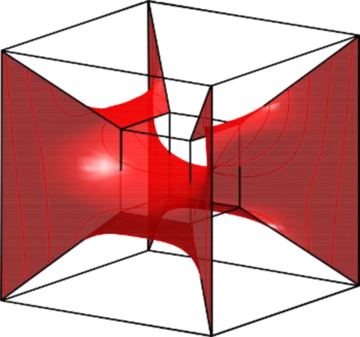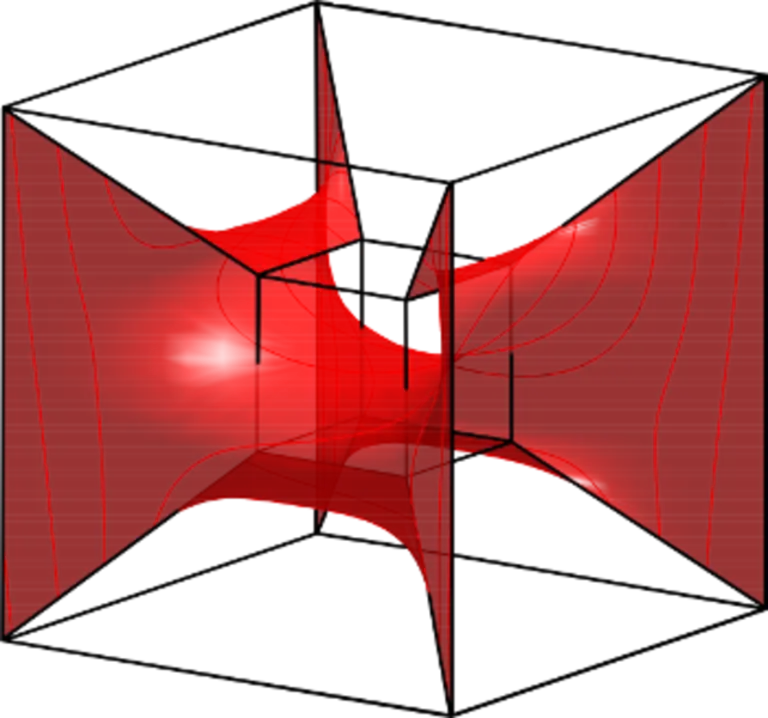
inBook
2020
Repository Open Access
Deep Ritz revisited
In: ICLR 2020 workshop on integration of deep neural models and differential equations : Millennium Hall, Addis Ababa, Ethiopia ; 26th April 2020[S. L.] : ICLR, 2020.
inJournal
2022
Repository Open Access
Natural reweighted wake-sleep
In: Neural networks, 155 (2022), pp. 574-591MiS Preprint
2020
Repository Open Access
Natural Wake-Sleep Algorithm
inJournal
2023
Journal Open Access
On the locality of the natural gradient for learning in deep Bayesian networks
In: Information geometry, 6 (2023) 1, pp. 1-49inBook
2020
Repository Open Access
On the space-time expressivity of ResNets
In: ICLR 2020 workshop on integration of deep neural models and differential equations : Millennium Hall, Addis Ababa, Ethiopia ; 26th April 2020[S. L.] : ICLR, 2020.
inBook
2019
Repository Open Access
A continuity result for optimal memoryless planning in POMDPs
In: RLDM 2019 : 4th multidisciplinary conference on reinforcement learning and decision making ; July 7-10, 2019 ; Montréal, CanadaMontréal, Canada : University, 2019. - pp. 362-365
inBook
2019
Repository Open Access
Task-agnostic constraining in average reward POMDPs
In: Task-agnostic reinforcement learning : workshop at ICLR, 06 May 2019, New Orleans[S. L.] : ICLR, 2019.
Preprint
2018
Repository Open Access
Illustration of maxout layer upper bound [Suppl. to: On the number of linear regions of deep neural networks]
inBook
2018
Repository Open Access
Uncertainty and stochasticity of optimal policies
In: Proceedings of the 11th workshop on uncertainty processing WUPES '18, June 6-9, 2018 / Václav Kratochvíl (ed.)Praha : MatfyzPress, 2018. - pp. 133-140
inJournal
2017
Journal Open Access
Dimension of marginals of Kronecker product models
In: SIAM journal on applied algebra and geometry, 1 (2017) 1, pp. 126-151inBook
2017
Repository Open Access
Geometry of policy improvement
In: Geometric science of information : Third International Conference, GSI 2017, Paris, France, November 7-9, 2017, proceedings / Frank Nielsen... (eds.)Cham : Springer, 2017. - pp. 282-290
(Lecture notes in computer science ; 10589)
inBook
2015
Repository Open Access
Hierarchical models as marginals of hierarchical models
In: Proceedings of the 10th workshop on uncertainty processing WUPES '15, Moninec, Czech Republic, September 16-19, 2015 / Václav Kratochvíl (ed.)Praha : Oeconomica, 2015. - pp. 131-145
inBook
2017
Repository Open Access
Notes on the number of linear regions of deep neural networks
In: 2017 international conference on sampling theory and applications (SampTA) / Gholamreza Anbarjafari... (eds.)Piscataway, NJ : IEEE, 2017. - pp. 156-159
inJournal
2017
Repository Open Access
Restricted Boltzmann machines [In: Algebraic statistics ; 16 April - 22 April 2017 ; report no. 20/2017]
In: Oberwolfach reports, 14 (2017) 2, pp. 1241-1242inBook
2015
Repository Open Access
Mode poset probability polytopes
In: Proceedings of the 10th workshop on uncertainty processing WUPES '15, Moninec, Czech Republic, September 16-19, 2015 / Václav Kratochvíl (ed.)Praha : Oeconomica, 2015. - pp. 147-154
inBook
2015
Repository Open Access
A comparison of neural network architectures
In: Deep learning Workshop, ICML '15, Vauban Hall at Lille Grande Palais, France, July 10 and 11, 20152015.
inJournal
2015
Journal Open Access
A theory of cheap control in embodied systems
In: PLoS computational biology, 11 (2015) 9, e1004427inBook
2015
Repository Open Access
Deep narrow Boltzmann machines are universal approximators
In: Third international conference on learning representations - ICLR 2015 : May 7-9 2015, San Diego, CA. USASan Diego : ICLR, 2015.
inJournal
2015
Journal Open Access
Discrete restricted Boltzmann machines
In: Journal of machine learning research, 16 (2015), pp. 653-672inJournal
2015
Journal Open Access
Geometric design principles for brains of embodied agents
In: Künstliche Intelligenz : KI, 29 (2015) 4, pp. 389-399Preprint
2015
Repository Open Access
Geometry and determinism of optimal stationary control in partially observable Markov decision processes
inJournal
2015
Journal Open Access
Geometry and expressive power of conditional restricted Boltzmann machines
In: Journal of machine learning research, 16 (2015), pp. 2405-2436inJournal
2017
Repository Open Access
Hierarchical models as marginals of hierarchical models
In: International journal of approximate reasoning, 88 (2017), pp. 531-546Preprint
2015
Repository Open Access
Universal approximation of Markov kernels by shallow stochastic feedforward networks
inJournal
2015
Repository Open Access
When does a mixture of products contain a product of mixtures?
In: SIAM journal on discrete mathematics, 29 (2015) 1, pp. 321-347inBook
2014
Geometry of hidden-visible products of statistical models
In: Algebraic Statistics 2014 : May 19-22Chicago, IL : Illinois Institute of Technology, 2014.
inJournal
2014
Journal Open Access
On the Fisher metric of conditional probability polytopes
In: Entropy, 16 (2014) 6, pp. 3207-3233inBook
2014
Repository Open Access
On the number of inference regions of deep feed forward networks with piece-wise linear activations
In: Second international conference on learning representations - ICLR 2014 : 14-16 April 2014, Banff, CanadaBanff : ICLR, 2014.
inBook
2014
Repository Open Access
On the number of linear regions of deep neural networks
In: NIPS 2014 : Proceedings of the 27th international conference on neural information processing systems - volume 2 ; Montreal, Quebec, Canada, December 8th-13thCambridge, MA : MIT Press, 2014. - pp. 2924-2932
inJournal
2014
Repository Open Access
Robustness, canalyzing functions and systems design
In: Theory in biosciences, 133 (2014) 2, pp. 63-78inJournal
2014
Journal Open Access
Scaling of model approximation errors and expected entropy distances
In: Kybernetika, 50 (2014) 2, pp. 234-245inJournal
2014
Repository Open Access
Universal approximation depth and errors of narrow belief networks with discrete units
In: Neural computation, 26 (2014) 7, pp. 1386-1407inBook
2013
Repository Open Access
Maximal information divergence from statistical models defined by neural networks
In: Geometric science of information : first international conference, GSI 2013, Paris, France, August 28-30, 2013. Proceedings / Frank Nielsen... (eds.)Berlin [u. a.] : Springer, 2013. - pp. 759-766
(Lecture notes in computer science ; 8085)
inJournal
2013
Journal Open Access
Mixture decompositions of exponential families using a decomposition of their sample spaces
In: Kybernetika, 49 (2013) 1, pp. 23-39inBook
2013
Repository Open Access
Selection criteria for neuromanifolds of stochastic dynamics
In: Advances in cognitive neurodynamics III : proceedings of the 3rd International Conference on Cognitive Neurodynamics 2011 ; [June 9-13, 2011, Hilton Niseko Village, Hokkaido, Japan] / Yoko Yamaguchi (ed.)Dordrecht : Springer, 2013. - pp. 147-154
(Advances in cognitive neurodynamics)
Academic
2012
On the expressive power of discrete mixture models, restricted Boltzmann machines, and deep belief networks - a unified mathematical treatment
Dissertation, Universität Leipzig, 2012inBook
2012
Repository Open Access
Scaling of model approximation errors and expected entropy distances
In: Proceedings of the 9th workshop on uncertainty processing WUPES '12 : Marianske Lazne, Czech Republik ; 12-15th September 2012Praha : Academy of Sciences of the Czech Republik / Institute of Information Theory and Automation, 2012. - pp. 137-148
inBook
2011
Repository Open Access
Expressive power and approximation errors of restricted Boltzmann machines
In: Advances in neural information processing systems 24 : NIPS 2011 ; 25th annual conference on neural information processing systems 2011, Granada, Spain December 12th - 15th / John Shawe-Taylor (ed.)La Jolla, CA : Neural Information Processing Systems, 2011. - pp. 415-423
inJournal
2011
Repository Open Access
Refinements of universal approximation results for deep belief networks and restricted Boltzmann machines
In: Neural computation, 23 (2011) 5, pp. 1306-1319inBook
2010
Repository Open Access
Mixture models and representational power of RBM's, DBN's, and DBM's
In: NIPS 2010 : Deep learning and unsupervised feature learning workshop ; December 19, 2010, Hilton, Vancouver, Canada[s. l.] : NIPS, 2010. - pp. 1-9
Academic
2010
Repository Open Access
On boundaries of statistical models
Dissertation, Universität Leipzig, 2010inJournal
2006
Journal Open Access
Maximizing multi-information
In: Kybernetika, 42 (2006) 5, pp. 517-538Academic
2001







